The euro hits my exact Fibonacci target
Elliott wave theory and Fibonacci levels are by themselves useful. Use them in combination, says John C Burford, and you have a powerful tool.
When I last covered the euro on 12 August, it appeared the dollar was ready for a rally. In other words, the EUR/USD was setting up for a decline.
This was the daily chart then:
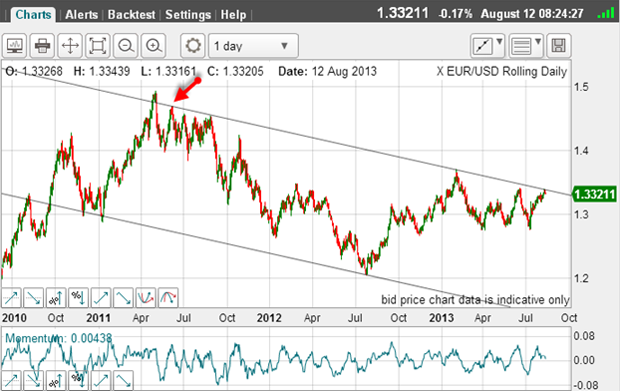
As I explained then, I have a very solid tramline pair working which I believed I could count on to contain future trading.
MoneyWeek
Subscribe to MoneyWeek today and get your first six magazine issues absolutely FREE

Sign up to Money Morning
Don't miss the latest investment and personal finances news, market analysis, plus money-saving tips with our free twice-daily newsletter
Don't miss the latest investment and personal finances news, market analysis, plus money-saving tips with our free twice-daily newsletter
On the hourly chart:
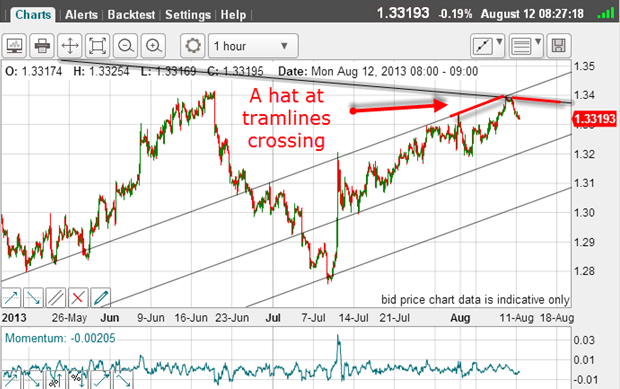
I made a strong case that the market had topped at the 1.34 area, as it made a hit on the strong resistance formed by the meeting of the upper tramline and the down-trending tramline on the daily chart.
These hats are very powerful areas of super-strong resistance a double dose.
So let's see how a short trade taken in this area worked out.
My EUR/USD short trade
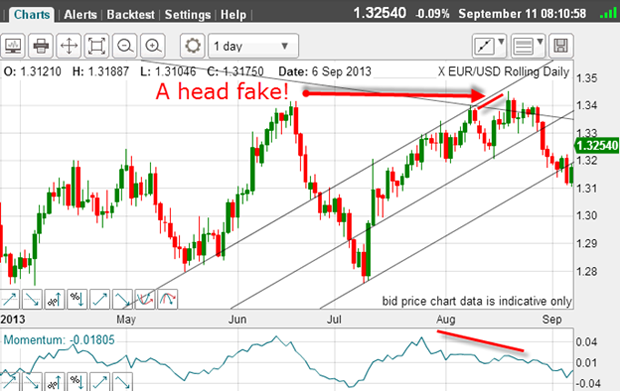
The market did indeed start declining from that 1.34 point, but found support at my centre tramline and then rallied back up over 1.34 and slightly above my down-sloping tramline (but not above my upper up-sloping tramline!).
This is what I call a head fake and these can give you nightmares at the time. When you are in one although you cannot possibly know it will be a head fake at the time you really question your analytical abilities and sanity!
But the move above 1.34 was accompanied by a negative-momentum divergence (red bars) a clear sign that the buying power was drying up.
Now, if you were trading with a close buy-stop, you may well have been stopped out on the spike up to the 1.3450 high.
Now this is where your discipline comes into play.
Do you abandon your efforts (or perhaps go long on the tramline break), or do you look for another short entry, relying on your previous analysis?
As it happened, the 1.3450 level was the top and the market quickly came back to trade under the main tramline. That was a signal that we had a genuine head fake and a sign to look for another short entry.
As the market broke sharply through the centre tramline, a clear sell signal was presented.
And where was the market likely to find support on this move?
Let's apply the Fibonacci levels to the entire rally off the 9 July low:
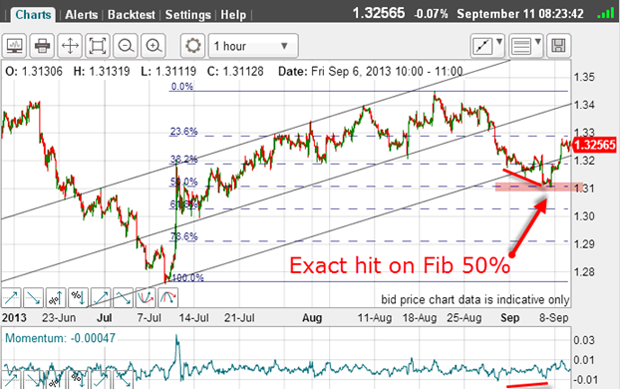
Remember, applying Fibonacci retrace levels is automatic when we have a retrace of a previous wave in progress.
And to prove once again just how powerful and extremely useful the Fibonacci levels are the decline stopped at 1.31 - the precise Fibonacci 50% retrace. Isn't that pretty?
Another clue that the decline would turn there was the budding positive-momentum divergence at the 1.31 level.
That was a clear signal to take short-term profits of around 300 - 350 pips from the short trade.
Interestingly, the bounce off the 1.31 level took the market back up through my lower tramline. This is a sign that these tramlines are not working so well any more. There are probably other tramlines now being formed. But I will keep them for now until I see a different pattern emerge.
So let's fast forward to this morning:
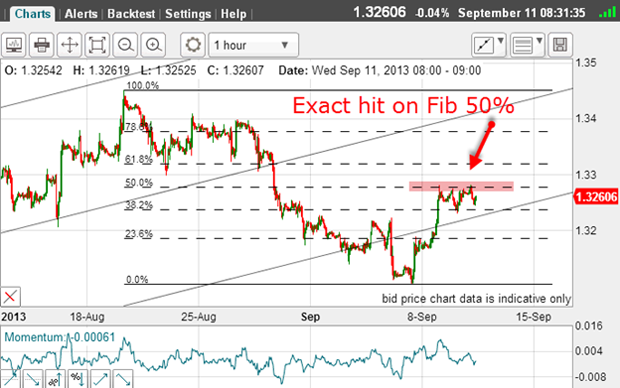
The market hit the 1.31 level last Friday and has been in rally mode since.
I can therefore apply the Fibonacci levels to the decline off the 1.3450 high.
And guess what the rally has been stopped dead at the exact Fibonacci 50% retrace! We have yet another 50% correction and another place to look to enter a short trade.
Why am I favouring the short side? The market is in a long-term downtrend, and I can count Elliott waves in the short-term. Let's take a look:
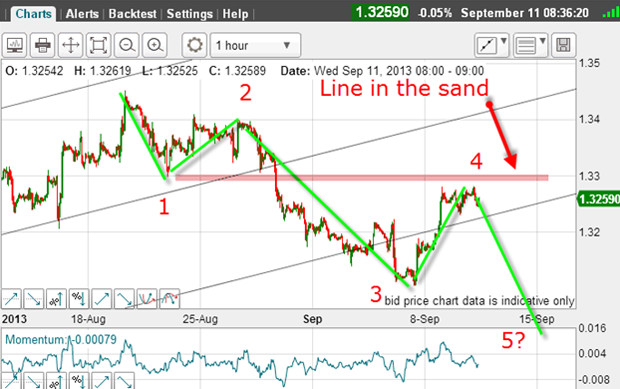
I can count waves 1, 2, 3 and 4. If the w4 top holds, then we can expect a move down to w5.
But there is an alternative count the move down to w3 could be an A-B-C, which would imply an extension to the rally.
A 1, 2 , 3 , 4 count would imply the opposite. And my w3 is long and strong, lending credence to this scenario.
So we have two opposite possible outcomes, both of equal merit.
How do we tell which one will win out?
One of the Elliott wave theory rules is that in an impulse pattern of 1, 2 , 3 , 4 and 5 is that w4 must not overlap the price region of w1.
Here, it means that w4 must not move above the w1 low of 1.33, otherwise we would likely have a rally extension on our hands. A small spike in and out would be OK.
So that gives us a solid guide for placing protective stops.
OK, if the market does rally from here, the underside of my centre tramline is a tempting target, where a kiss and a scalded cat bounce would be the likely scenario, depending on how the waves play out in the meantime.
So I hope you see how both Elliott wave theory and Fibonacci combined can offer you some solid and logical trade ideas and provide you with sensible stop loss placements.
Get the latest financial news, insights and expert analysis from our award-winning MoneyWeek team, to help you understand what really matters when it comes to your finances.
John is is a British-born lapsed PhD physicist, who previously worked for Nasa on the Mars exploration team. He is a former commodity trading advisor with the US Commodities Futures Trading Commission, and worked in a boutique futures house in California in the 1980s.
He was a partner in one of the first futures newsletter advisory services, based in Washington DC, specialising in pork bellies and currencies. John is primarily a chart-reading trader, having cut his trading teeth in the days before PCs.
As well as his work in the financial world, he has launched, run and sold several 'real' businesses producing 'real' products.
-
 The shape of yields to come
The shape of yields to comeCentral banks are likely to buy up short-term bonds to keep debt costs down for governments
-
 The sad decline of investment clubs – and what comes next
The sad decline of investment clubs – and what comes nextOpinion Financial regulation and rising costs are killing off investment clubs that once used to be an enjoyable hobby, says David Prosser